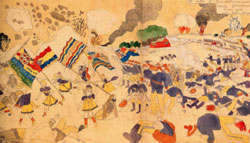Two exhibitions
dal 24/3/2005 al 5/6/2005
Segnalato da
Francis Alÿs, Ida Applebroog, Clive Barker, Hans Bellmer, Christian Boltanski, Mat Collishaw, Dorothy Cross, Adam Dant, Henry Darger
Erno Goldfinger
Roger Hilton
Joan Jonas
Glenn Kaino
Wassily Kandinsky
Zbigniew Libera
Melissa McGill
Wendy McMurdo
Annette Messager
Piet Mondrian
The Brothers Quay
Paula Rego
Gerrit Rietveld
Laurie Simmons
Kiki Smith
Monika Sosnowska
Richard Wentworth
Sarah Woodfine
Kumi Yamashita
Salvator Rosa
Marina Warner
24/3/2005
Two exhibitions
Compton Verney House Trust, Warwickshire
'Only Make-Believe: Ways of Playing' introduces the key modern theories of child psychologists and educationalists and traces the effect that these theories had on the development of creativity. The second exhibition, 'Wild Landscapes', explores the wild nature of Salvator Rosa's landscapes through paintings, drawings and etchings.

Only Make-Believe: Ways of Playing
Henry Darger. At battle of Drosabellamaximillian. Seeing Glandelinians retreating Vivian girls grasp Christian banners, and lead the charge against foe. Mid twentieth century. Picture credit: Kiyoko LernerOnly Make-Believe explores the innate relationship between play, make-believe and art, through the work of over thirty modern and contemporary artists. The link between play and creativity deepened during the twentieth-century and the exhibition focuses on the important historical, social, psychological and cultural aspects of this subject.
This exhibition includes the work of Francis Alÿs, Ida Applebroog, Clive Barker, Hans Bellmer, Christian Boltanski, Mat Collishaw, Dorothy Cross, Adam Dant, Henry Darger, Erno Goldfinger, Roger Hilton, Joan Jonas, Glenn Kaino, Wassily Kandinsky, Zbigniew Libera, Melissa McGill, Wendy McMurdo, Annette Messager, Piet Mondrian, The Brothers Quay, Paula Rego, Gerrit Rietveld, Laurie Simmons, Kiki Smith, Monika Sosnowska, Richard Wentworth, Sarah Woodfine and Kumi Yamashita.
The exhibition introduces the key modern theories of child psychologists and educationalists, such as Friedrich Wilhelm Froebel, Melanie Klein and Maria Montessori, and traces the effect that these theories had on the development of creativity. These methods, which emphasise abstract shapes, building blocks, geometric and biomorphic forms, had a direct influence on modern art and architecture, on the Bauhaus aesthetic and the development of abstraction and graphic codes of communication. At the same time, ideas about the imaginative world of the child contributed to the work of the Surrealists and outsider artists. Only Make-Believe explores these themes and also focuses on contemporary approaches to fairy tale, illusion, fantasy and magic.
Only Make-Believe includes an extensive collection of rarely seen objects and art works, both historical, contemporary and specially commissioned, to create a universal world of memory and imagination, where mimicry, performance, masquerade and ritual all feature. The power and relevance of make-believe has never been more potent than it is today, and the artists’ ability to communicate experience through make-believe offers a way of illuminating the world around us.
Loans for this exhibition have come from a diverse range of public and private collections including the American Folk Art Museum, New York; Institute of Psychoanalysis, London; RIBA; British Museum;Tate; Froebel College, Roehampton University; Bodleian, Oxford; National Gallery of Scotland; Museum of Scotland; National Trust; Brontë Parsonage Museum, Haworth; Horniman Museum, London and the Museum of Childhood, Bethnal Green. The exhibition will be accompanied by a fully illustrated catalogue with contributions by Mary Jacobus, Susan Stewart and Marina Warner.
Salvator Rosa: Wild Landscapes
Salvator Rosa. Jacob’s Dream. 1650s. Picture credit: The Devonshire Collection, ChatsworthSalvator Rosa (1615-73) is one of the best-known seventeenth century Neapolitan artists celebrated for his wild landscapes. His subjects, with their dramatic lighting and elemental locations set a precedent in the eighteenth century for the ‘sublime’ in landscape painting. This important exhibition at Compton Verney is the first show of Rosa’s work to be presented in Britain since the 1970s.
The exhibition explores the wild nature of Rosa’s landscapes through paintings, drawings and etchings. Over forty works are featured, including important paintings such as Landscape with Mercury and the Dishonest Woodman (c.1655-60); Self-Portrait (1641); Empedocles Leaping into Etna (c.1660s) and Jacob’s Dream (c.1650s).
Rosa’s early training was in Naples, and it was here that he learnt to paint directly onto the canvas, often creating oil sketches from nature, which contributed greatly to the freedom of his painting. In 1635 Rosa left Naples for Rome and in 1640 became court painter for the Medici family in Florence. However, Rosa longed for greater freedom and spent his summers in northern Tuscany where he formed his distinctive landscape style. In 1649 he broke completely with the Medici court and returned to Rome, where he lived until his death in 1673.
Amongst Italian artists Rosa was ranked with Claude Lorraine and Gaspard Dughet. He created a significant new form of landscape painting, which often formed backdrops for scenes from classical myth and contemporary folklore, where the turbulent and ferocious energy of nature is expressed with a remarkable sense of awe. Rosa’s popularity flourished during the eighteenth century as his work was brought back from Italy and featured in many of the great private collections in England.
By the early nineteenth century much of Rosa’s work was in British ownership, marking an unprecedented popularity for a foreign artist. Another reason for Rosa’s popularity was that vivid stories about his life began to proliferate, which added an instant glamour to his reputation. Although these were largely myth, Rosa became a cult figure, often referred to in poems and treatises, and his influence on other artists at the time such as Henry Fuseli and Joseph Wright of Derby was substantial.
By focusing on this important and under-represented Neapolitan artist this exhibition complements Compton Verney’s permanent collection of Neapolitan art. Works for this exhibition have been loaned from both public and private collections including the British Museum; National Gallery; Eastnor Castle and Chatsworth.
Displayed alongside Rosa’s work is sculpture by artists Mariele Neudecker and Tania Kovats, whose work represents their own response to the sublime power of landscape.
Image: Salvator Rosa
Curated by Marina Warner
Compton Verney House Trust
Compton Verney
Warwickshire CV35 9HZ



